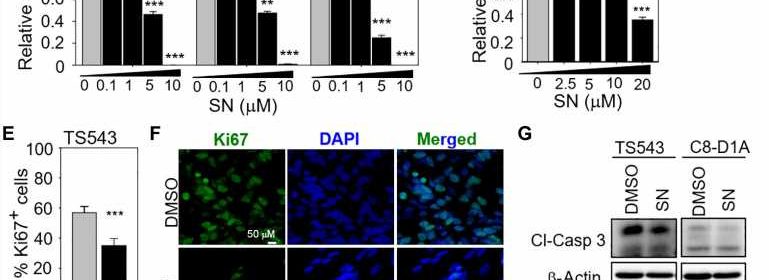Glioblastoma dependent on biotin distribution

Glioblastoma is the most lethal and malignant adult brain cancer that may arise from neuroglial stem or progenitor cells. Certain gene mutations or those with a known history of other cancers and radiation therapy may predispose patients to develop brain cancer. Tumor relapse is invariably inevitable due to the resistance of glioblastoma towards standard therapies. Additionally, the infiltrative nature of these tumor cells means it is often not possible to surgically remove them completely.
Researchers from NUS Yong Loo Lin School of Medicine have discovered that the FDA-approved anti-fungal drug, sulconazole, exhibits anti-cancer properties towards glioblastoma cells. This was published in the latest issue of Science Advances. An in-depth investigation of this compound revealed that it competes with biotin (vitamin H), an important co-factor for metabolic enzymes and modifier of histones, allowing it to inhibit the normal function of biotin-dependent metabolic enzymes and specific histone modification-associated gene expression. This compromises glioblastoma metabolism and epigenetics, thereby impairing the tumor growth and invasiveness of glioblastoma cells.
In mammalian cells, holocarboxylase synthetase, or HLCS, is the enzyme that serves to distribute biotin to the biotin-dependent proteins. Gene silencing of HLCS mitigates the glioblastoma’s tumorigenicity—its tendency to develop tumors—in mouse models. High HLCS expression is also associated with glioblastoma and inferior glioma patient outcome. While HLCS is present in healthy patients, its expression increases in the tumors of glioblastoma patients. Glioblastoma cells with higher HLCS expression will be able to better supply biotin to the biotin-dependent metabolic enzymes and histones, which results in a more proliferative and invasive glioblastoma. Thus, the dependency of glioblastoma on biotin distribution suggests that the rational co-targeting of biotin-dependent metabolism and epigenetic pathways may be explored for glioblastoma eradication.
Source: Read Full Article
![Fig. 1. Identification of SN as a previously unknown anti-GSC compound. (A) CMA using the EGFRlowMeslowGNhigh signature identifies SN. (B and D) Cell viability assay of GSCs and mouse astrocytes with 3 days of SN treatment (n = 8) (means ± SD). (C) Tumorsphere formation of GSCs following SN treatment for 5 days (n = 6) (means ± SD). (E) Ki67 immunostaining of GSC with or without 5 μM SN treatment for 3 days (n = 5) (mean ± SD). (F) Representative images of (E). (G) Western blot analysis of cleaved-caspase 3 from DMSO or 5 μM SN-treated cells (3 days). β-Actin serves as the loading control. (H) Transwell migration and invasion assay of GSCs with 5 μM SN pretreatment (3 days) (n = 3) (means ± SD). (I) Representative images of (H). (J) Heatmap for selected genes in the EGFR, Mes, and GN gene sets after treatment of GSC TS543 with 5 μM SN versus DMSO control (3 days). Gene expressions [TPM (transcripts per million) values] were mean-normalized. Two-tailed unpaired Student’s t test. ***P < 1 × 10−4; **P < 0.001; *P < 0.05. Credit: DOI: 10.1126/sciadv.abf6033 Glioblastoma dependent on biotin distribution](https://scx1.b-cdn.net/csz/news/800a/2021/glioblastoma-dependent.jpg)